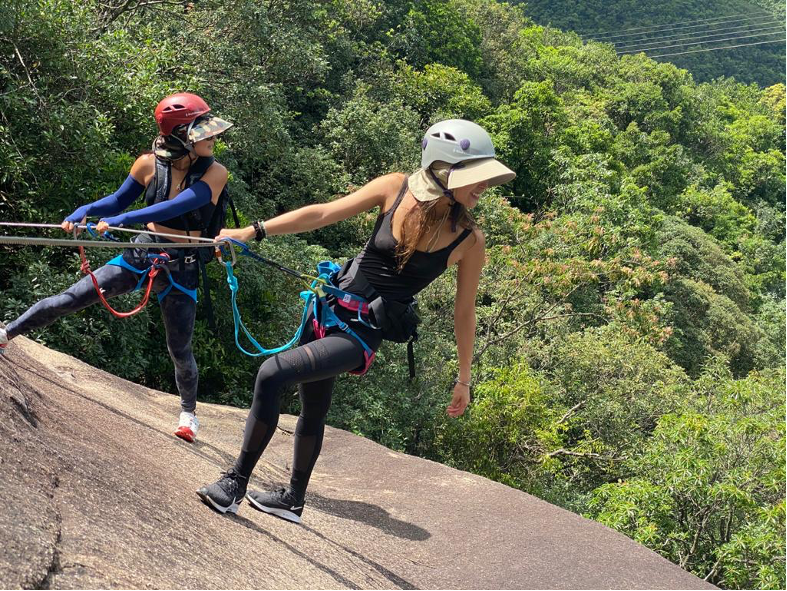Rock climbing has always fascinated me. Even before the famous documentaries Dawn Wall and Free Solo, I have always been drawn to the wildness and unpredictability of mountains. I held my breath as I watched Tony Caldwell complete the first free climb of the Dawn Wall of El Capitan in Yosemite National Park. After six years of planning and preparation, his 19-day ascent of the Dawn Wall was considered by some as the most difficult successful rock climb in history. It was not only his courage that I strongly admired but the relentless determination he had, as he conquered the seemingly impossible feat of climbing with the loss of a finger.
As with many sports, the mental aspect of the challenge is no doubt as important as one’s physical capabilities – rock climbing is no different. While browsing exotic locations in the world to try, like Yangshuo in Guilin or The Grand Canyon in the United States, I thought, why don’t I start with rock climbing in Hong Kong? Before I even began to google where and how to begin, my best friend and adventure buddy, Alison Chan, called me excitedly and said we should definitely sign up for a half-day climbing course together.
Antonia Li and Alison Chan rock climbing at Black's Link
Photo: Tony Cheung and Karen Chan
At 9am one lovely morning in late August, we met our instructor Paul Yuen (@paul.yuen_) at Black’s Link where we then made our way to the rock climbing spots. Less than a 10 minute hike up, we abseiled to the rock climbing spots with various rock climbing lanes of beginner and advanced levels.
In Hong Kong, we use the French grading system. The grade consists of a number which goes from 1 to 9 and a letter, from a to c. Both describe the difficulty of the climb. For more difficult grades, a “+” sign is also included. It is an added level of specificity that allows climbers to more accurately grade their climbs.
Starting our course, we learnt the fundamental basics and safety of rock climbing. These are absolutely crucial. Paul taught us how to do an 8 knot which is the most secure way to tie a knot. You then hook it through your carabiner to ensure you are buckled in safely. It is compulsory that you verbally announce that you “begin climbing” to your partner as communication is the key to your safety – you should keep communication clear at all times with your partner belaying you at the bottom and ensuring that the tension is tight. There is a misconception that you require a lot of upper body strength to rock climb. In fact, we are taught to secure our foot stance holding first on the rocks before using our hands to find the right place to grip and then to pull ourselves upwards. If you keep using your upper body to pull yourself up, you will exhaust yourself very easily.
Antonia Li climbing Black's Link
Photo: Tony Cheung and Karen Chan
As I climbed up F5+, pushing my back along the lines and ridges of the rocks for upward mobility, there was definitely some struggling and moments of panic as I tried to secure a stable foot stance on the ridges of the wall. Climbing further up the wall, Alison and Paul’s figures started to look smaller and smaller as their voices grew fainter. I had to rationalize my fear and shaky hands and remind myself that the fear in my stomach was merely a bundle of nerves.
What I found most enlightening is that through rock climbing, you learn how to confront your fears and rationalise your thoughts in moments of adversary. As much as rock climbing is a partnership-based sport, it is also very much a solo journey, especially when you are up there alone. To my surprise, the more scared you are, the clearer your mind becomes, and it is up to you to work your way to the top. There are so many moments that you may think you have to give up, so many doubts that you could ever do it but once you work through them, you will feel an immense sense of accomplishment because what seemed utterly impossible was in fact, possible. And it was only because you made it happen.
Antonia Li climbing Black's Link
Photo: Tony Cheung and Karen Chan
Apart from trusting yourself, what is really important is to trust others. I found belaying more challenging than climbing up the wall as I had to trust the person belaying me 100%. Once you decide to descend, you need to lean back into thin air as if you are sitting down on an invisible chair and walk yourself down against the wall. One step at a time, legs wide and straight, down the mountain wall.
After a few tries, Alison and I were sitting on top of the hill of Black’s Link. Enjoying the skyline and grinning from ear to ear as we could not believe that we made it! We conquered this mountain!
Antonia Li climbing Central Crag
Photo: Tony Cheung and Karen Chan
Rock climbing showed us the importance of building trust in relationships around and within yourself. Communication is also key to success. After a nerve wracking, exciting day filled with adrenaline, we took home a vital lesson from rock climbing that we can apply well in our lives.
If you are an adventurer who enjoys pushing your boundaries, this is the sport for you.
Photography by Tony Cheung and Karen Chan
Editor
Antonia Li









